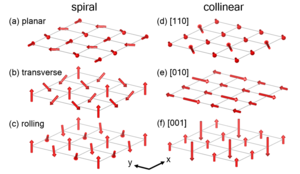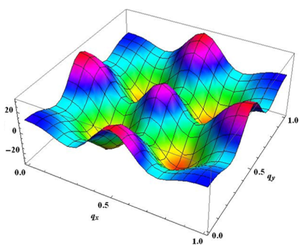Anisotropy of magnetic interactions and symmetry of the order parameter in unconventional superconductor Sr2RuO4
Category: Scientific HighlightsPublished in Quantum Materials
Unconventional superconductivity: role of magnetic interactions in strontium ruthenate
An international team of researchers led by the University of Vienna (Computational Materials Physics) has presented a new framework for analyzing the role of magnetic interactions on the unconventional superconductivity in strontium ruthenate. The results have been published in the Nature partner journal "Quantum Materials".
Strontium ruthenate (Sr2RuO4) is a layered oxide perovskite superconductor that used to be touted a potential three-dimensional analogue of Helium-3, as it was thought to have the same type of chiral p-wave pairing. It is now widely accepted that this is not the case, but many questions remain over the exact nature of the pairing, particularly regarding the role of magnetic interactions.
An international team of researchers involving the University of Vienna (Cesare Franchini and Bongjae Kim), the Vienna University of Technology (Sergii Khmelevskyi), the Naval Research Laboratory (Igor Mazin), and the University of Wisconsin (Daniel F. Agterberg) has presented a framework that can incorporate the leading isotropic and anisotropic magnetic interactions in a different but complimentary way to the widely used Hubbard-model, providing an alternative way of exploring the superconducting pairing symmetry.
The results of these study, based on first principle calculations in the framework of the density functional theory and performed using the Vienna Ab-initio Simulation Package (VASP), indicate that spiral magnetic interactions arising from relatively strong relativistic (spin-orbit coupling) effects are essential to interpret all the major experimental observations. Also, this study shows that rotating a p-wave superconducting order parameter during measurements of the Knight shift is impossible by several orders of magnitude and thus the invariance of the shift in the nuclear magnetic resonance frequency (i.e. the Knight shift) across the transition remains an unresolved puzzle. Moreover, the authors propose a model framework, based on a double-exchange type Hamiltonian, and incorporating the calculated magnetic interactions in their entirety, and present an example of using this framework for addressing superconducting pairing symmetry.


Lowest energy magnetic structures and exchange interaction in Sr2RuO4
Project part: P15 - Collective Phenomena in Oxide Films and Hetero-structures
Original publication: Kim, B., Khmelevskyi, S., Mazin, I.I., Agterberg, D.F., Franchini, C., 2017. Anisotropy of magnetic interactions and symmetry of the order parameter in unconventional superconductor Sr2RuO4. npj Quantum Materials 2. DOI:10.1038/s41535-017-0041-8
Published by npj Quantum Materials under the terms of the Creative Commons Attribution 4.0 International license.
Sensengasse 8/12
A-1090 Vienna
AUSTRIA
T: +43-1-4277-51401
F: +43-1-4277-9514


